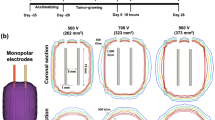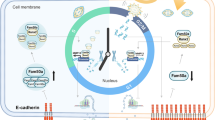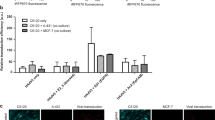Abstract
Uniform DNA distribution in tumors is a prerequisite step for high transfection efficiency in solid tumors. To improve the transfection efficiency of electrically assisted gene delivery to solid tumors in vivo, we explored how tumor histological properties affected transfection efficiency. In four different tumor types (B16F1, EAT, SA-1 and LPB), proteoglycan and collagen content was morphometrically analyzed, and cell size and cell density were determined in paraffin-embedded tumor sections under a transmission microscope. To demonstrate the influence of the histological properties of solid tumors on electrically assisted gene delivery, the correlation between histological properties and transfection efficiency with regard to the time interval between DNA injection and electroporation was determined. Our data demonstrate that soft tumors with larger spherical cells, low proteoglycan and collagen content, and low cell density are more effectively transfected (B16F1 and EAT) than rigid tumors with high proteoglycan and collagen content, small spindle-shaped cells and high cell density (LPB and SA-1). Furthermore, an optimal time interval for increased transfection exists only in soft tumors, this being in the range of 5–15 min. Therefore, knowledge about the histology of tumors is important in planning electrogene therapy with respect to the time interval between DNA injection and electroporation.
This is a preview of subscription content, access via your institution
Access options
Subscribe to this journal
Receive 12 print issues and online access
$259.00 per year
only $21.58 per issue
Buy this article
- Purchase on Springer Link
- Instant access to full article PDF
Prices may be subject to local taxes which are calculated during checkout





Similar content being viewed by others
References
Nishikawa M, Huang L . Non-viral vectors in the new millennium: delivery barriers in gene transfer. Hum Gene Ther 2001; 12: 861–870.
Cemazar M, Golzio M, Sersa G, Rols MP, Teissie J . Electrically-assisted nucleic acids delivery to tissues in vivo: where do we stand? Curr Pharm Des 2006; 12: 3817–3825.
Heller LC, Heller R . In vivo electroporation for gene therapy. Hum Gene Ther 2006; 17: 890–897.
Cemazar M, Grosel A, Glavac D, Kotnik V, Skobrne M, Kranjc S et al. Effects of electrogenetherapy with p53wt combined with cisplatin on curvival of human tumor cell lines with different p53 status. DNA Cell Biol 2003; 22: 765–775.
Haupt S, Haupt Y . Manipulation of the tumor suppressor p53 for potentiating cancer therapy. Semin Cancer Biol 2004; 14: 244–252.
Bettan M, Ivanov MA, Mir LM, Boissiere F, Delaere P, Scherman D . Efficient DNA electrotransfer into tumors. Bioelectrochemistry 2000; 52: 83–90.
Cemazar M, Sersa G, Wilson J, Tozer GM, Hart SL, Grosel A et al. Effective gene transfer to solid tumors using different non-viral gene delivery techniques: electroporation, liposomes, and integrin-targeted vector. Cancer Gene Ther 2002; 9: 399–406.
Heller L, Jaroszeski MJ, Coppola D, Pottinger C, Gilbert R, Heller R . Electrically mediated plasmid DNA delivery to hepatocellular carcinomas in vivo. Gene Therapy 2000; 7: 826–829.
Rols MP, Delteil C, Golzio M, Dumond P, Cros S, Teissie J . In vivo electrically mediated protein and gene transfer in murine melanoma. Nat Biotechnol 1998; 16: 168–171.
Wells JM, Li LH, Sen A, Jahreis GP, Hui SW . Electroporation-enhanced gene delivery in mammary tumors. Gene Therapy 2000; 7: 541–547.
Cichon T, Jamrozy L, Glogowska J, Missol-Kolka E, Szala S . Electrotransfer of gene encoding endostatin into normal and neoplastic mouse tissues: inhibition of primary tumor growth and metastatic spread. Cancer Gene Ther 2002; 9: 771–777.
Collins CG, Tangney M, Larkin JO, Casey G, Whelan MC, Cashman J et al. Local gene therapy of solid tumors with GM-CSF and B7-1 eradicates both treated and distal tumors. Cancer Gene Ther 2006; 13: 1061–1071.
Grosel A, Sersa G, Kranjc S, Cemazar M . Electrogene therapy with p53 of murine sarcomas alone or combined with electrochemotherapy using cisplatin. DNA Cell Biol 2006; 25: 674–683.
Lucas ML, Heller L, Coppola D, Heller R . IL-12 plasmid delivery by in vivo electroporation for the successful treatment of established subcutaneous B16.F10 melanoma. Mol Ther 2002; 5: 668–675.
Tamura T, Nishi T, Goto T, Takeshima H, Ushio Y, Sakata T . Combination of IL-12 and IL-18 of electro-gene therapy synergistically inhibits tumor growth. Anticancer Res 2003; 23: 1173–1179.
Gehl J . Electroporation: theory and methods, perspectives for drug delivery, gene therapy and research. Acta Physiol Scand 2003; 177: 437–447.
Li S . Electroporation gene therapy: new developments in vivo and in vitro. Curr Gene Ther 2004; 4: 309–316.
Somiari S, Glasspool-Malone J, Drabick JJ, Gilbert RA, Heller R, Jaroszeski MJ et al. Theory and in vivo application of electroporative gene delivery. Mol Ther 2000; 2: 178–187.
Smrekar B, Wightman L, Wolschek MF, Lichtenberger C, Ruzicka R, Ogris M et al. Tissue-dependent factors affect gene delivery to tumors in vivo. Gene Therapy 2003; 10: 1079–1088.
Zaharoff DA, Barr RC, Li CY, Yuan F . Electromobility of plasmid DNA in tumor tissues during electric field-mediated gene delivery. Gene Therapy 2002; 9: 1286–1290.
Canatella PJ, Black MM, Bonnichsen DM, McKenna C, Prausnitz MR . Tissue electroporation: quantification and analysis of heterogeneous transport in multicellular environments. Biophys J 2004; 86: 3260–3268.
Baumgartner G . The impact of extracellular matrix on chemoresistance of solid tumors – experimental and clinical results of hyaluronidase as additive to cytostatic chemotherapy. Cancer Lett 1998; 131: 1–2.
Davis AJ, Tannock IF . Tumor physiology and resistance to chemotherapy: repopulation and drug penetration. Cancer Treat Res 2002; 112: 1–26.
Tannock IF, Lee CM, Tunggal JK, Cowan DS, Egorin MJ . Limited penetration of anticancer drugs through tumor tissue: a potential cause of resistance of solid tumors to chemotherapy. Clin Cancer Res 2002; 8: 878–884.
Grantab R, Sivananthan S, Tannock IF . The penetration of anticancer drugs through tumor tissue as a function of cellular adhesion and packing density of tumor cells. Cancer Res 2006; 66: 1033–1039.
Minchinton AI, Tannock IF . Drug penetration in solid tumours. Nat Rev Cancer 2006; 6: 583–592.
Netti PA, Hamberg LM, Babich JW, Kierstead D, Graham W, Hunter GJ et al. Enhancement of fluid filtration across tumor vessels: implication for delivery of macromolecules. Proc Natl Acad Sci USA 1999; 96: 3137–3142.
Netti PA, Berk DA, Swartz MA, Grodzinsky AJ, Jain RK . Role of extracellular matrix assembly in interstitial transport in solid tumors. Cancer Res 2000; 60: 2497–2503.
Pluen A, Boucher Y, Ramanujan S, McKee TD, Gohongi T, Tomaso E et al. Role of tumor-host interactions in interstitial diffusion of macromolecules: cranial vs subcutaneous tumors. Proc Natl Acad Sci USA 2001; 98: 4628–4633.
Alexandrakis G, Brown EB, Tong RT, McKee TD, Campbell RB, Boucher Y et al. Two-photon fluorescence correlation microscopy reveals the two-phase nature of transport in tumors. Nat Med 2004; 10: 203–207.
Valic B, Golzio M, Pavlin M, Schatz A, Faurie C, Gabriel B et al. Effect of electric field induced transmembrane potential on spheroidal cells: theory and experiment. Eur Biophys J 2003; 32: 519–528.
Susil R, Semrov D, Miklavcic D . Electric field-induced transmembrane potential depends on cell density and organization. Electro- and Magnetobiology 1998; 17: 391–399.
Cemazar M, Pavlin D, Kranjc S, Grosel A, Mesojednik S, Sersa G . Sequence and time dependence of transfection efficiency of electrically-assisted gene delivery to tumors in mice. Curr Drug Deliv 2006; 3: 77–81.
Mir LM, Bureau MF, Gehl J, Rangara R, Rouy D, Caillaud JM et al. High-efficiency gene transfer into skeletal muscle mediated by electric pulses. Proc Natl Acad Sci USA 1999; 96: 4262–4267.
Gimsa J, Wachner D . Analytical description of the transmembrane voltage induced on arbitrarily oriented ellipsoidal and cylindrical cells. Biophys J 2001; 81: 1888–1896.
Sixou S, Teissie J . Specific electropermeabilization of leucocytes in a blood sample and application to large volumes of cells. Biochim Biophys Acta 1990; 1028: 154–160.
Andre FM, Cournil-Henrionnet C, Vernerey D, Opolon P, Mir LM . Variability of naked DNA expression after direct local injection: the influence of the injection speed. Gene Therapy 2006; 13: 1619–1627.
Hanahan D, Weinberg RA . The hallmarks of cancer. Cell 2000; 100: 57–70.
Golzio M, Rols MP, Teissie J . In vitro and in vivo electric field-mediated permeabilization, gene transfer, and expression. Methods 2004; 33: 126–135.
Prud'homme GJ, Glinka Y, Khan AS, Draghia-Akli R . Electroporation-enhanced non-viral gene transfer for the prevention or treatment of immunological, endocrine and neoplastic diseases. Curr Gene Ther 2006; 6: 243–273.
Cemazar M, Wilson I, Dachs GU, Tozer GM, Sersa G . Direct visualization of electroporation-assisted in vivo gene delivery to tumors using intravital microscopy - spatial and time dependent distribution. BMC Cancer 2004; 4: 81.
Acknowledgements
The authors acknowledge financial support from the state budget of the Slovenian Research Agency (program No. P3-0003; project No. J3-7044). Grateful acknowledgement is also extended to Mira Lavric for her help with experiments.
Author information
Authors and Affiliations
Corresponding author
Rights and permissions
About this article
Cite this article
Mesojednik, S., Pavlin, D., Sersa, G. et al. The effect of the histological properties of tumors on transfection efficiency of electrically assisted gene delivery to solid tumors in mice. Gene Ther 14, 1261–1269 (2007). https://doi.org/10.1038/sj.gt.3302989
Received:
Revised:
Accepted:
Published:
Issue Date:
DOI: https://doi.org/10.1038/sj.gt.3302989
Keywords
This article is cited by
-
Efficient In Vitro Electropermeabilization of Reconstructed Human Dermal Tissue
The Journal of Membrane Biology (2015)
-
Muscle gene electrotransfer is increased by the antioxidant tempol in mice
Gene Therapy (2012)
-
Gene Transfer: How Can the Biological Barriers Be Overcome?
The Journal of Membrane Biology (2010)
-
Control by pulse parameters of DNA electrotransfer into solid tumors in mice
Gene Therapy (2009)
-
Gene electrotransfer: from biophysical mechanisms to in vivo applications
Biophysical Reviews (2009)



